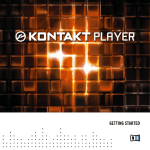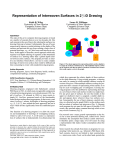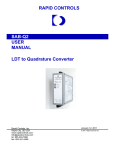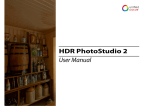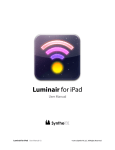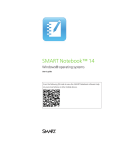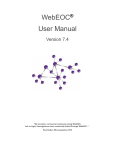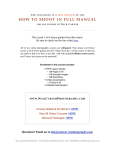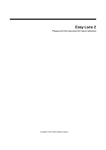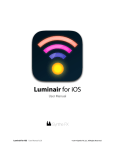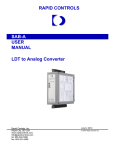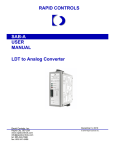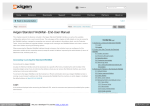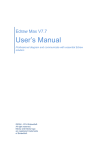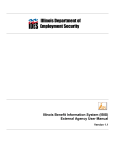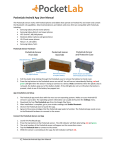Download iDraw User Guide
Transcript
User Guide iDraw for Mac OS X v2.5.1 1 Welcome to iDraw Vector Illustration Getting Started Creating a New Document 6 6 8 8 Interface Overview 10 Document Tabs 11 Switching Between Documents 11 Closing Documents 11 Toolbar 12 Tool Options 13 Layers 15 Creating Layers 15 Working with Multiple Layers 16 Duplicating Layers 16 Deleting Layers 16 Arranging Layers 16 Merging Layers 17 Moving Objects Between Layers 17 Layer Effects 17 Blending Modes 18 Colors and Gradients 20 Stroke and Fill Colors 20 Color Palette 20 Color Panel 21 Gradient Palette 21 Inspector Panels Appearance Panel 22 23 2 Properties Panel 24 Shapes Panel 25 Styles Panel 26 Tools 27 Move Tool 28 Path Selection Tool 31 Pen 34 Convert Tool 37 Brush 38 Pencil 38 Eraser 39 Text 40 Line 41 Arc 41 Rectangle Tool 42 Rounded Rectangle Tool 42 Ellipse Tool 42 Polygon Tool 43 Star Tool 43 Rotate 44 Scale 45 Shear 46 Zoom Tool 47 Hand Tool 47 Gradient Tool 48 Image Tool 49 Importing Images 50 Importing SVG Files 50 Stroke Settings 51 3 Brushes 52 Fill Settings 53 Labels and Dimensioning 55 Text Settings 57 Effects 58 Geometry 59 Alignment 59 Path Tools 60 Grid Settings 62 Canvas Settings 64 Preferences 65 Exporting Designs 66 Ready, Set, Draw! 67 4 Thank you for purchasing iDraw! This user guide will help you become familiar with the powerful set of drawing tools and features available in iDraw, getting you up and running quickly. iDraw has been designed from the start to have a beautiful, clean, and easy to use interface - with the goal of creating a powerful drawing application which takes advantage of the native features in Mac OS X and iOS, and is both fun and rewarding to use. iDraw for Mac OS X iDraw for iPad Create, edit, and share designs between both the Mac and iPad versions of iDraw. 5 Welcome to iDraw iDraw is a feature-packed vector illustration application, with all the tools you need to create everything from intricate designs to beautiful works of art. iDraw was created from the ground-up as a native Mac OS X application, fully taking advantage of Cocoa, Core Graphics, and many of the other powerful technologies in Mac OS X. Vector Illustration Unlike bitmap drawing applications, which focus on editing the individual pixels of an image, vector designs are created using objects and paths. Vector paths - consisting of points, lines, and curves - can be painted and filled. Multiple paths can be used together to create detailed intricate objects, while multiple objects can then be arranged to create a larger design. Original - 100% Scaling a bitmap image vs. scaling a vector image. The original vector image remains crisp when enlarged, without any loss of quality. A bitmap version of the same image loses quality when enlarged. Bitmap Image - 400% Zoom Vector Image - 400% Zoom 6 One of the many benefits of vector drawing is that each drawn object remains fully editable throughout the entire process of creating a design. Object paths are always modifiable, while the colors and fill styles applied to a path can be changed at any time to alter the look of a design. This is in contrast to bitmap painting applications, in which each drawing tool directly changes the pixels of an image. For example, modifying the color of a brush stroke in a bitmap painting after it has been drawn is not possible without redrawing that portion of the design. Vector object, consisting of multiple individual paths Object paths shown selected, filled with colors and gradients. Finished design Vector illustrations are resolution-independent. Objects, or entire designs, can be resized to larger or smaller sizes without any loss of quality. Even if you are unfamiliar with vector drawing, this guide will help you become comfortable with creating your own designs using the various tools available in iDraw. 7 Getting Started When launching iDraw for the first time, you will be presented with the Welcome Screen. From this panel you have the option to create a new document, open an existing iDraw document using the Open Panel, or open a recently edited iDraw document. The Welcome Screen can be viewed at any time from the Help > Show Welcome Screen menu item. Creating a New Document To create a new document, you can choose ‘Create a New Document’ from the Welcome Screen, or select File > New [ ⌘-N ] from the menu bar. The New Document panel allows you to select the canvas style, size, and measurement units for the new document. 8 1. Canvas Style - Choose from a variety of canvas styles - including graph paper, notebook paper, and blueprint - for the perfect canvas for a particular project. All canvas styles are created using variations of the built-in grid and background color settings, making them fully customizable. Customize your document further using the Canvas and Grid Settings panes. 2. Presets - Quickly choose the size for the new document from a list of preset sizes. Simply choose a preset from the list, such as Letter or A4, and the dimensions of that preset automatically fill the width and height fields. 3. Width and Height - Enter values for the width and height of the new document. Landscape or portrait documents can be created by varying the width and height values. Documents can have a maximum canvas size of 16,000 x 16,000 pixels. The size of the document can be changed later in the Canvas Settings pane. 4. Units - Select the measurement units to be used for the new document. The possible unit types include pixels, inches, centimeters, and millimeters. The width and height field values are specified in these units. The measurement units can also be changed later in the Canvas Settings pane. 5. Color Mode - Select the color mode to be used in the document, RGB or CMYK. 9 Interface Overview iDraw uses a primarily single-window interface, with a few accompanying inspector panels for additional settings and features. The toolbar on the left side of the document window provides access to the available drawing and editing tools, while the Layers pane on the right side of the window can be used to work with the current document’s layers. Documents can be managed quickly and easily using the Tab Bar at the top of the window. Tools Document Tabs Layers Canvas Color Wells 10 Document Tabs Rather than require you to constantly swap between many scattered windows - one for each open document - iDraw uses an elegant tab-based interface for switching between open documents. Document tabs are shown in the Tab Bar (directly below the window’s title bar). Each open document is represented by a tab, with the current document shown as a lighter-colored ‘selected‘ tab. Document Tabs Current Document Close Tab/ Document Switching Between Documents You can switch between open documents by clicking on a particular document’s tab in the Tab Bar. The document for the clicked tab is then selected and shown in the Canvas area of the document window. Documents Popup The documents popup can also be used to switch between open documents. Access the popup by clicking on the doublearrow button on the right side of the Tab Bar. Closing Documents You can close any open document by clicking on the close button in its tab. To close the currently active document, you can choose File > Close Document [ ⌘-W ] from the menu bar. Keyboard Shortcuts Close Document Close Window 11 Toolbar The toolbar on the left side of the document window allows you to choose between the various drawing and editing tools available in iDraw. Using the different tools you can: • Position and resize objects using the Move tool. • Edit paths, anchor points, and curves using the Path Selection and Convert Anchors tools. Selected Tool • Create new paths and shapes using the Pen, Brush, Pencil, and shape drawing tools. • Scale, rotate, and shear objects using the transform tools. • Pan and zoom the canvas using the Hand and Zoom tools. • Change the current stroke and fill colors using the toolbar color wells. Tools To select and use a tool simply click on its icon in the toolbar. The name of the currently selected and active tool is shown in the indicator above the toolbar. Below the tools are the Stroke and Fill color wells, which can be used to change the current stroke and fill settings. Tip: Quickly switch between the different tools by using their keyboard shortcuts. Hover over each tool with the mouse to view a tooltip showing its name and keyboard shortcut. Fill Color Stroke Color 12 Tool Options Many of the tools in iDraw have customizable settings that allow you to adjust their behavior. The settings for the currently selected tool appear in the Tool Options Bar above the Canvas area. The tool options for the Polygon Tool Selected Tool Cursor Location/ Selected Origin Selected Width and Height Selected Tool's Settings Selected Tool The name of the currently selected tool appears on the left side of the Tool Options Bar. Selection Properties The Selection Properties are shown to the right of tool’s name. When no objects are selected, this indicator simply displays the X and Y position of the mouse on the Canvas. When one or more objects are selected, this displays location and size of the bounding box surrounding the current selection. Selected Tool Settings The settings for the currently selected tool are displayed to the right of the Selection Properties. - For selection tools, including the Move and Path Selection tools, this area will display additional information about the current selection. - For drawing tools, this area will display settings that can be used to customize the objects that are created by that tool. - For editing tools, such as the Rotate and Scale tools, this area will contain controls that allow you to numerically apply the effects of the tool. 13 Canvas The Canvas is the visible area that defines a design. It is where illustrations are created; where objects are drawn and edited. The grey patterned area surrounding the canvas is non-printable ‘scratch’ space. Objects can overlap into this area, or they can be placed here while a design is being edited, however anything outside of the canvas will not be visible when printing or exporting the design. Canvas Size The size of the canvas can be changed at any time from the Canvas Settings pane. The measurement units used for dimensions can be set to pixels, inches, millimeters, or centimeters. Background The background of the canvas can be set to be either a solid color, gradient, or image (using the Canvas Settings pane). Rulers and Grid The Rulers and Grid are helpful when positioning and aligning objects. When selecting objects, highlights appear on the rulers showing the bounds of the current selection. To toggle the rulers, choose View > Show / Hide Rulers [ ⌘-R ]. To enable grid snapping choose View > Snap to Grid [ ⌘-Shift-’ ]. You can customize the grid using the Grid Settings pane. Keyboard Shortcuts Show/Hide Rulers Show/Hide Grid Toggle Snap to Grid 14 Layers Layers offer the ability to manage and organize complex designs easily, by separating a large design into sections of related objects. Each layer is like a sheet of transparent paper drawn on top of the layers below it. Layers are drawn as a ‘stack’, with the layer at the bottom of the list drawn first and each following layer drawn on top of the previous one. Layers also offer the ability to create unique effects through the use of their opacity and blending mode settings. These settings determine how a layer will blend with the layers below it. The Layers list on the right side of the document window can be used to create, rename, arrange, delete, and select layers. Creating Layers To create a new layer, click on the ‘Add Layer’ button ( ). A new empty layer will be created above the currently selected layer. Show/Hide Layer Lock/Unlock Layer Selected Layer Blending/Opacity of Slected Layer Delete Layer Layer Actions Menu Add Layer To change the name of a layer, simply double-click on the layer’s name field, to the right of its thumbnail. 15 Working with Multiple Layers When a document has more than one layer, you can choose the layer you wish to edit by selecting it. The currently selected layer is shown in blue in the Layers list, and is the active layer; newly created objects will be added to this layer, and the objects in this layer can be selected and modified. To select a different layer, simply click on it in the Layers list. A common example for using multiple layers is tracing an imported image. When tracing, it can be helpful to draw in a layer on top of the image. Toggling the visibility of the image layer underneath can then be used to occasionally check the current progress of the drawing. Layers can be toggled between hidden and visible using the visibility checkbox (to the left of the layer’s thumbnail). Duplicating Layers At times it can be useful to create an exact duplicate of an existing layer, including copies of the objects within that layer. To duplicate a layer, choose ’Duplicate Layer’ from the layers action menu ( ), or Arrange > Duplicate Layer from the menu bar. Deleting Layers To delete the currently selected layer, click on the ‘Delete Layer’ button ( ). This will remove the layer and all of its objects. Arranging Layers You can change the order of a layer by dragging it to a new position in the Layers list. Click and drag the layer you’d like to move, and drop it in a new position. While dragging, a blue indicator line will show the destination of the dragged layer. 16 Merging Layers The contents of two layers can be merged into one single layer. To merge two layers, select the layer on top and choose ‘Merge Down’ from the layers action menu ( ), or choose Arrange > Merge Layer Down from the menu bar. You can also access the layers action menu by right-clicking on a layer. Moving Objects Between Layers You can move objects from one layer to another using cut and paste. Select the objects you’d like to move and choose Edit > Cut [ ⌘-X ]. Next, select the destination layer from the Layers list by clicking on it. Finally, paste the copied objects into the new layer using Edit > Paste in Place [ ⌘-Shift-V ], which will paste the objects using their exact previous positions. Layer Effects The Opacity and Blending Mode settings of a layer affect how it will blend with the layers underneath it. You can change these settings for the currently selected layer using the controls at the bottom of the Layers list. Keyboard Shortcuts Create New Layer Duplicate Layer Merge Layer Down Delete Layer 17 Blending Modes Examples showing the result of applying each available Blending Mode setting. Normal Darken Multiply Color Burn Lighten Screen Color Dodge Overlay Soft Light 18 Hard Light Difference Exclusion Hue Saturation Color Luminosity 19 Colors and Gradients Each object in iDraw is composed of one or more vector paths. Object paths are drawn by drawing the line around the path (Stroke) and drawing the area inside of the path (Fill). Strokes are drawn based on their width and color. Fills can be either a color, a gradient, or an image. Stroke Fill Stroke Color Fill Color Stroke and Fill Colors The Stroke and Fill color wells in the toolbar can be used to set the current stroke and fill colors. Drawing tools will use these colors when creating new objects. When objects are selected, the stroke and fill color wells update to the colors used by those objects. Changing the stroke or fill colors while objects are selected will change the objects’ colors. To disable the drawing of an object’s stroke or fill, you can set the color to ‘none’ ( ). Color Palette The Color Palette can be used to quickly choose a color, as well as save and reuse frequently used colors. Aside from the Stroke and Fill color wells, color wells appear throughout iDraw’s interface which can be used to set the color for a specific setting, from grid line colors to the document’s background color. Clicking on a color well will bring up the floating color palette. Colors can be added to the color palette by clicking on the add button ( ) at the bottom of the palette. You can use the Color Panel to choose new colors that can be added. To remove a color simply right-click on it and choose Remove Color. 20 Color Panel To choose a custom color not available in the Color Palette, the Color Picker can be used. To show the Color Picker open the drop-down menu and simply select it. The Color Panel can select colors using a variety of different color picker interfaces, from a Color Wheel to RGB, CMYK, HSB, and Grayscale sliders. The Alpha slider at the bottom of the panel can be used to make colors semi-transparent. The color setting being modified is shown as the title of the Color Panel. Eyedropper Tool The Eyedropper Tool can be used to select a color by picking the color of any pixel on the screen. To activate the Eyedropper Tool, click on its icon in the Color Panel ( ). The cursor will become an Eyedropper that shows a magnified area of the pixels underneath it. Clicking on any pixel on the screen will choose that color. Gradient Palette Unlike strokes, fills can be set to gradients as well as colors. The palette for the Fill color well has options for choosing either a color or a gradient. Switch between color and gradient fills using the control at the top of the palette. Gradients can be added to the gradient palette by clicking on the add button ( ) at the bottom of the palette. Create new gradients using the gradient editor in the Fill Settings pane in the Appearance Panel. To remove a gradient simply right-click on it and choose Remove Gradient. 21 Inspector Panels In addition to the main document window, iDraw also offers four floating inspector panels with additional features. Each panel has a distinct role, from changing various object settings to saving and reusing styles and object libraries. Show / hide each Inspector Panel using the toolbar buttons, or using the Window menu. Appearance Panel Properties Panel Shape Libraries Layers Panel Styles Panel The Properties and Appearance panels both have multiple panes of settings. You can switch between settings panes using the tab bar at the top of the panel. Each floating inspector panel can be moved anywhere on screen. A panel can be collapsed by clicking on its title bar, and snapped to the top or bottom of another inspector panel. Arranging Windows To automatically snap and arrange the inspector panels on the right side of the main screen choose Window > Arrange Inspectors from the menu bar. To automatically resize and position the document window alongside the inspector panels on the main screen, choose Window > Arrange Windows. The Properties panel with the Geometry Settings tab selected. Multiple inspector panels collapsed and snapped together 22 Appearance Panel The Appearance panel includes several panes of settings for modifying the appearance of objects. Stroke Brush Fill Modify an object’s stroke width and color. Add line endings or set custom line dashes. Apply a calligraphic brush stroke to a path. Edit settings for brush roundness, angle, and diameter. Set and customize an object’s fill. Choose from color, gradient, and image fills. Label Text Effects Set object labels, with adjustable position and alignment settings. Choose between dimension and custom text labels. Select font, size, and alignment settings for text objects. Convert a text object to editable paths. Adjust the opacity of an object, and apply and edit drop shadows. 23 Properties Panel The Properties panel includes several panes of settings that allow you to position, align, and modify objects. The last two sections contain settings for customizing the grid and canvas. Geometry Alignment Path Tools Numerically set the position and size of an object or group. Apply the shear and rotation transformations. Arrange objects from front to back, create groups, and align object positions relative to one another. Combine multiple paths using union, subtract, intersect, exclude, and divide operations. Create compound paths. Grid Canvas Customize the canvas grid. Adjust X and Y spacing, subdivisions, and margins. Use color settings to create different paper styles. Set the canvas size and units. Use a scale factor to customize the display of measurements for ‘to-scale’ designs. Adjust the canvas background. 24 Shapes Panel The Shapes panel manages libraries of reusable shapes. You can create your own libraries, save shapes, and reuse them throughout multiple projects. iDraw includes a few built-in example libraries to help you get you started. The included shapes can be used to add symbols or annotations to an existing design, create floor plan layouts, and even design iPhone app mockups. Using Shapes Saved shapes can be organized into libraries of related objects. To switch between libraries, simply select one from the popup menu. The shapes for the selected library appear in the pane below. To add a shape to a design simply drag it from the list onto the canvas. Creating a New Shape Library To create a new empty shape library, choose New Shape Library... from the action button to the right of library popup ( ). You will be prompted to enter a name for the new library. Saving a Shape To save a shape to a custom shape library, simply select an object the canvas and click on the add button ( ) at the bottom of the Shapes Panel. Note: Shapes can be added to custom shape libraries, but not to the built-in libraries. Removing a Saved Shape You can remove a shape that was previously added to a custom library by right-clicking on it in the shapes pane and choosing Remove Shape from Library from the context menu. Removing a Shape Library To delete the selected shape library, choose Remove Shape Library... from the action button ( ). Note: The built-in shape libraries cannot be removed. 25 Styles Panel The Styles panel can be used to save and reuse the appearance settings of an object. Styles can be applied to any type of object, including lines, shapes, and text objects. Applying a Style To apply a style to an object in your document, first select the target object. Next, click on the desired style in the Styles pane. The appearance of the selected object will change to match the picked style. Saving a Style To save the appearance settings of a particular object as a style, first select the object. Click on the add button at the bottom of the Styles panel ( ). A new style item will appear in the Styles pane matching the appearance settings of the selected object. Styles can be saved for line objects with ends and labels, shape objects with strokes and fills, or text objects with font and alignments settings. Removing a Saved Style To remove a saved style, simply right-click on it in the Styles pane and choose Remove Style from the context menu. 26 Tools Move Tool (V) Select, move, and resize objects Pen (P) Create paths with lines and curves Brush (B) Draw brush strokes Eraser (E) Erase portions of objects or paths Line (L) Create straight line segments Rectangle (M) Create rectangles Ellipse (O) Create circles and ellipses Star (J) Create stars with varying points Scale (S) Scale objects Hand (H) Move the visible area of the canvas Path Selection Tool (A) Select and edit path points and curves Convert Tool (Shift-C) Modify path curves Pencil (N) Draw freeform paths Text (T) Add text objects Arc (K) Create elliptical arcs Rounded Rect (Shift-M) Create rectangles with round corners Polygon (Shift-O) Create polygon shapes Rotate (R) Rotate objects Shear (Shift-S) Slant objects Zoom Tool (Z) Select, move, and resize objects Fill (X) Shows the selected fill, the color or gradient used to fill areas enclosed by paths Stroke Color (X) Shows the selected stroke color, the color used to draw paths 27 Move Tool The Move tool is used to select and move objects or groups. Besides being the primary tool for selecting entire objects, it can also be used to quickly resize and rotate a selection of objects. Select an object by simply clicking on it. Multiple objects can be selected by holding down the SHIFT key while clicking on them. Click on an object to select it SHIFT + click to select multiple objects Another way of selecting multiple objects is by clicking on an empty part of the canvas and dragging to create a selection rectangle. Objects touched by the selection rectangle are selected. Tip: Press and hold the OPTION key to select only objects that are inside the selection rectangle. Moving Objects Objects can be moved by clicking on them and dragging to a new position. To constrain movement to a single direction, hold down the SHIFT key while dragging 28 Selection Info When one or more objects are selected with the Move tool, the Tool Options bar will display information about the current selection, including the position, size, and types of objects selected. Position and size of current selection Objects in selection The Bounding Box The bounding box is the box that appears around the currently selected objects. Aside from showing the bounds of the selection, it also allows you to quickly transform the selected objects. Draggable handles are located at the corners and sides of the bounding box. You can click and drag any of theses handles to resize the bounding box and the selected objects. Dragging a corner handle to resize the selected objects Tip: Holding down the SHIFT key while resizing will maintain the proportions of the objects. 29 Moving the mouse pointer slightly outside of a bounding box handle will change the cursor to a curve with arrows at each end. Clicking and dragging in this mode will rotate the selected objects. Rotating objects using by dragging a bounding box handle Tip: Holding down the SHIFT key while rotating will constrain the rotation to 15˚ increments. Nudging Objects Selected objects can be nudged slightly in any direction by using the arrows keys on the keyboard. Editing Fills The Move tool can also be used to activate the Gradient Tool or Image Tool, when editing objects with those types of fills. To edit an object’s fill, simply click once to select the object and then click a second time to activate the Gradient or Image tool. When finished, click elsewhere on the canvas to return to the Move tool. Gradient Tool Image Tool 30 Path Selection Tool The Path Selection tool can be used to select and modify the points and curves of a path. It allows you to modify shapes by moving and deleting path points, and adjusting the curved sections of a path. Objects in iDraw are composed of vector paths. Paths themselves are made up of anchor points connecting straight lines and curved segments. Anchor points are shown on a path as empty squares, while selected anchor points are shown as filled squares. Click on an anchor point to select it, and then drag to move it. Moving a selected anchor point Direction handles that appear on either side of a selected anchor point control the curvature of the path at that location. Moving a direction handle will modify the shape of the curve at that anchor point. 31 Direction handles are shown as a filled circle with a line extending to the anchor point. Click and drag on a direction handle to modify a curve. Dragging a direction handle to modify a curve Multiple points on a path can be selected and edited at the same time. To select multiple points, either click and drag on the canvas to create a selection rectangle or hold down the SHIFT key while clicking on each point. Selecting points using a selection rectangle Using SHIFT + click to select multiple points Note: The Path Selection tool can also be used to select multiple paths at once. However, to edit the anchor points of a path, only a single path (or compound path) should be selected. Modifying Curves Moving a direction handle with the Path Selection tool will adjust the curvature of the path segment at a specific point. Anchor 32 points with two direction handles, one at each side, are smooth points. Moving the direction handle on one side of these points will automatically move the opposite direction handle to maintain the smoothness of the curve at that point. To create a sharper angle at an anchor point, you can move a direction handle while holding down the OPTION key: Dragging a direction handle & holding the OPTION key Resulting sharp corner at the anchor point Alternatively, you can click and drag a smooth anchor point with the OPTION key held down to create a sharp curve at that point: Moving an anchor point while holding the OPTION key Resulting sharp curve Deleting Path Points Anchor points can be removed from a path by simply selecting them with the Path Selection tool and pressing the DELETE key. Pressing DELETE to remove the selected anchor points 33 Pen The Pen tool can be used to draw any kind of shape, using a combination of straight lines and curves. Because of its versatility, it is the most important of iDraw’s drawing tools to learn and become proficient using. The Pen tool can be used to create straight line segments, by simply clicking on the canvas. Creating a series of line segments by clicking to add path points Closing an in-progress path by clicking on the first point in the path. To finish editing a path, simply click on the first point in the path to close it. Alternatively, pressing the ESC key will end editing the current path without closing it. After closing the current path, or ending editing by pressing the ESC key, the Pen tool can be used to create a new path. To create curved segments, click and drag to create anchor points with direction handles. Clicking and dragging to create an anchor point with direction handles Direction handles are used to create a curved segment on a path 34 Creating a Line Segment after a Curve A straight line segment can be drawn after a curve segment by removing the direction handle at the end of the path. Simply click on the last anchor point to remove the direction handle. After creating a curve segment, direction handles appear at each side Clicking on the last path point removes the end direction handle Clicking (without dragging) now creates a line segment after the curve Creating a Curve after a Line Segment A curved segment can be drawn after a line segment by creating a direction handle at the end of the path. Simply click on the end anchor point and drag to create a direction handle. A straight line segment without direction handles Clicking on the last path point and dragging to create a direction handle A curved segment is added after the line Tip: Finish editing the current path without closing it by pressing the ESC key. 35 Appending an Existing Path The Pen tool can append additional segments to an existing unclosed path. First select the path to edit using the Move or Path Selection tools, then select the Pen tool. Click on one of the endpoints of the path to begin editing (or click and drag to create a direction handle). An existing path, selected with the Clicking one of the path’s endpoints Path Selection tool with the Pen tool to begin editing A curved segment is added to the path The Pen tool can also be used to add or remove points from any path. The Pen mode control in the Tool Options bar can be used to change the Pen tool from the default path creation mode, to the ‘Add Points’ or ‘Delete Points’ modes. First select the path to edit using the Move or Path Selection tools. Create Paths Add Points Cut Paths Delete Points Adding Path Points After choosing the ‘Add Points’ mode, simply click anywhere on the selected path to add a new anchor point. Adding an anchor point to a path Deleting Path Points After choosing the ‘Delete Points’ mode, simply click on any anchor point in the selected path to delete that point. Deleting an anchor point from a path 36 Convert Tool The Convert Tool can convert path points to either smooth points (anchor points with direction handles) or corners (anchor points without direction handles). To convert a corner point to a smooth point, simply click on the point with the Covert Tool and drag to create direction handles around the point. Star shape with corner points Corners converted to smooth points Original path Clicking an a corner point Dragging to create direction handles To convert a smooth point to a corner point, simply click on the point with the Covert Tool to remove the direction handles. You can also adjust the curvature of the path around a smooth point by dragging its direction handles. Clicking on a smooth point to convert it to a corner 37 Dragging direction handles with the Convert Tool to create a sharp angle at the anchor point Brush The Brush tool can be used to create calligraphic brush strokes. Calligraphic brushes create brush strokes which appear as if they were drawn using a calligraphic pen or paintbrush. Click and drag to draw a brush stroke. Brushes can be customized using the Brush Settings pane in the Appearance Panel. Brush strokes created with the Brush tool. You can adjust the brush width and the amount of smoothing applied to brush strokes using the settings in the Tool Options bar. Brush width and smoothing settings Pencil The Pencil tool can be used to draw freeform paths. It can be a great tool for creating a quick sketch of a design, since it can create paths quickly without needing to draw a segment at time as with the Pen tool. Click and drag to draw a path. As with the Brush tool, the Pencil tool has a smoothing setting which can be used to control the amount of smoothing applied to drawn paths. Adjust the line width and the amount of smoothing using the settings in the Tool Options bar. Sketch created by tracing an image with the Pencil tool 38 Eraser The Eraser tool can be used to erase portions of paths, or even entire shapes. As you click and drag with the eraser, a dark semi-transparent brush stroke will be drawn to show the areas to be erased. You can change the eraser’s brush size using the width setting in the Tool Options bar. When one or more objects are selected, the eraser will only modify the selected objects. If there are no objects selected, the eraser can be used to modify any object in the current layer. Text objects must first be converted to paths before they can be modified by the eraser. Erasing a portion of a path. Original grouped object Locked objects will not be modified by the Eraser tool. Dragging with the Eraser tool to remove part of the object The modified paths after erasing 39 Text The Text tool can be used to add text objects to a design, or edit previously created text objects. Create a new text field by clicking and dragging on the canvas. You can begin typing immediately to set the text after creating the text field. Clicking and dragging to create a text box To edit an existing text object, simply click on it with the Text tool active to begin typing. You can change the text properties, such as font, size, and alignment, of a text object using controls in the Tool Options bar or the Text Settings pane. To change the color of text, simply set the Fill color for the object. Text in iDraw can be styled like any other path object, meaning that text can also be filled with gradients or images, or have a stroke by setting the stroke width and color. Text objects can also be converted to editable vector paths. This allows you to edit each individual glyph, and edit the paths that make up the text using the Path Selection tool. Choose Modify > Convert Text to Path with a text object selected to convert it. Text object converted to vector paths Text! Mask Text object with a stroke and image fill 40 Line The Line tool can be used to create line segments. Besides creating plain lines, it can also be used to create lines which are styled with arrows and dimension lines. Select the desired type of line from the Tool Options bar. To create a line, simply click and drag on the canvas. Plain line Dimension Line Arrowed line Plain , Arrowed, and Dimension line The line endings for created lines can be customized using the Stroke Settings pane. When creating lines with the ‘Arrowed Line’ mode, the previously selected line endings will be used. For dimensions lines, the position and style of the dimension labels can be customized using the Label Settings pane. Create intricate drawings, such as floor plans or architectural designs, using lines, arrowed lines and dimension lines. Design with varying line styles Arc The Arc tool can be used to create arc segments. Click and drag on the canvas to create a new arc. The arc tool creates perfect circular arcs, however you can edit the start and end points of an arc’s path with the Path Selection tool. Top: Default arc object Below: Arcs with arrows and dimension styles applied As with lines, and other paths, you can customize the appearance of arcs using the Stroke Settings pane. 41 Rectangle Tool The Rectangle tool can be used to draw rectangles or squares. Click and drag to create a rectangle. Press the SHIFT key while dragging to create squares. Rounded Rectangle Tool The Rounded Rectangle tool can be used to draw rectangles with rounded corners. You can vary the roundness of the corners by adjusting corner radius setting in the Tool Options bar. Rounded corners can have a varying arc radius Ellipse Tool The Ellipse tool can be used to draw ellipses or circles. Click and drag to create an ellipse. Press the SHIFT key while dragging to create circles. 42 Polygon Tool The Polygon tool can be used to draw polygons with various numbers of sides, including triangles, hexagons, octagons, etc. The number of sides can be adjusted with ‘Sides’ setting in the Tool Options bar. Polygons can have a varying number of sides Star Tool The Star tool can be used to draw star shapes. You can adjust the number of points, and the length of each edge, using the settings in the Tool Options bar. Stars can have a varying number of points, and longer or shorter edges 43 Rotate The Rotate tool can be used to rotate objects around a reference point. To rotate one or more objects, first select the objects to be rotated and choose the Rotate tool. With the Rotate tool active, click and drag anywhere on the canvas to rotate the objects clockwise or counterclockwise. By default, the reference point will be located in the center of the selected shapes. To use a different location for the reference point, simply click (without dragging) to set it at that location. Selected object Click to set the reference point Click and drag to rotate Objects can be rotated numerically using the Tool Options bar. Set a rotation angle in the field and click ‘Rotate’ to apply the rotation. Clicking ‘Copy’ will duplicate the objects first and then apply the rotation to the copied objects. Applying a rotation Using ‘Copy’ to create multiple rotated objects 44 Scale The Scale tool can be used to resize objects relative to a reference point. To scale one or more objects, first select the objects to be scaled and choose the Scale tool. With the Scale tool active, click and drag anywhere on the canvas to resize the objects. By default, the reference point will be located in the center of the selected shapes. To use a different location for the reference point, simply click (without dragging) to set it at that location. Original objects Click and drag to resize the objects Objects can be scaled numerically using the Tool Options bar. Set the percent to scale in the width and height fields and click ‘Scale’ to apply the scaling. Clicking ‘Copy’ will duplicate the objects first and then apply the scale transform to the copied objects. Original objects duplicated and scaled using the ‘Copy’ option 45 Shear The Shear tool can be used to slant objects relative to a reference point, to give the appearance of a perspective. To shear one or more objects, first select the objects to be transformed and choose the Shear tool. With the Shear tool active, click and drag anywhere on the canvas to shear the objects. By default, the reference point will be located in the center of the selected shapes. To use a different location for the reference point, simply click (without dragging) to set it at that location. Selected objects Click and drag to shear Objects can be sheared numerically using the Tool Options bar. Set the angle of shear in the width and height fields and click ‘Shear’ to apply the transform. Clicking ‘Copy’ will duplicate the objects first and then apply the shear transform to the copied objects. 46 Zoom Tool The Zoom tool can be used to zoom in or zoom out the view of the canvas. Simply click on the canvas with the zoom tool selected to zoom in. Hold the OPTION key down while clicking to zoom out. The popup button on the bottom left of the canvas can also be used to change the zoom level ( ). 100% 300% Zoom 800% Zoom Hand Tool The Hand tool can be used to move the visible area of the canvas by clicking and dragging. Unlike scrolling with the scroll bars, the Hand tool can be used to reveal areas beyond the borders of the canvas. Tip: Use the hand tool to pan beyond the borders of the canvas. Moving of the canvas with the Hand tool 47 Gradient Tool The Gradient tool can be used to position the start and end points of a gradient fill relative to a shape’s bounds, changing the angle and spread of the gradient. With the Move tool active, click once to select an object which has a gradient fill. Click a second time on the object to edit its gradient fill. x2 The start and end points of the gradient will appear on the selected shape, and ‘Gradient Tool’ will display as the selected tool in the Tool Options bar. The gradient handles can be moved by simply dragging them. To reset the start and end points to their default positions, click the ‘Reset Gradient’ button in the Tool Options bar. Linear gradient Dragging to move the gradient start point Radial gradient Dragging to move the gradient end point 48 Image Tool The Image tool can be used to scale and position an image fill inside of a shape’s bounds, effectively cropping the image. With the Move tool active, click once to select an object which has an image fill. Click a second time on the object to edit the image. x2 A draggable resize handle will appear on the bottom right corner of the selected shape, and ‘Image Tool’ will display as the selected tool in the Tool Options bar. The image can be scaled, and positioned within the shape’s bounds by dragging. To reset the image’s size and position to the defaults, click ‘Reset’ in the Tool Options bar. When finished, click anywhere on the canvas to end editing and revert to the Move tool. Original image and bounding shape Dragging the handle to resize the image Enlarging the image further Dragging the image to crop it within the shape 49 Importing Images iDraw can import images formatted in many of the most popular file formats, including PNG, JPEG, GIF, TIFF, and more. PSD and PDF files can also be added as images and used as part of a design, or imported as fully layered documents (using File > Open...). To import an image into an existing document, simply drag the file from the Finder directly onto the canvas, or paste it in from another application. The image will be added as an object into the current layer. You can choose File > Place Image... [ ⌘-Option-I ] to add an image into a new layer in the current document. Alternatively, using File > Open... will create a new iDraw document with the chosen image. Images can also be used as a fill for any path object. Using this technique, an image can be masked to various shapes. You can set an image fill for an object using the Fill Settings pane. Setting an image fill Image fill masked to the shape Importing Vector SVG, PDF, AI Files SVG and PDF are common vector file formats, useful for sharing designs between applications. Most illustration applications can import and export designs in SVG or PDF, allowing you to import and edit these files in iDraw. To import an SVG, PDF or AI file into a new iDraw document choose File > Open... from the menu bar. Layered Photoshop PSD files can also be imported this same way. 50 Stroke Settings The Stroke settings pane is used to adjust a path’s stroke color, width, and style. Changes are applied to the currently selected objects. 1. Stroke Color - Set the color of the stroke. 2. Line Weight - Adjust the stroke’s thickness using the line weight slider, or input field. 3. Line Style - Choose from a variety of line endings and preset line dash styles using the line style popups. 4. Caps & Joins - Set the style of path endpoints (caps), and the path corners (joins). The Miter Limit field controls the maximum possible length of miter joins, with larger values allowing for longer join lengths. Butt Cap Rounded Cap Projecting Cap Miter Join Rounded Join Beveled Join Line endings and dash style popups 2 pt 3 pt 3 pt Custom line dash: 3 pt dash, 2 pt gap 5. Custom Line Dash - Create a custom line dash style using the dash and gap fields. Dash fields adjust the length of a dash, while gap fields adjust the space between dashes. 51 Brushes The Brushes pane allows you to choose the brush stroke to use when drawing with the Brush tool, or apply a calligraphic brush to any path object’s stroke. 1. Saved Brushes - Select one of the saved brushes by simply clicking on it. If objects are selected, the chosen brush will be applied to those object’s strokes. 2. Add Customized Brush - Click the add button to add a customized brush to the Saved Brushes list. To remove a brush from the list, right-click on it and choose Remove Brush from the context menu. 3. Brush Preview - Small preview of the currently chosen brush. 4. Brush Editor - You can use the Brush Editor to edit and customize brushes. Edit a brush manually by dragging the blue circular handles to change its angle and roundness, or edit the brush numerically by inputting values into the brush parameter fields. Roundness This setting determines the roundness of the brush. Higher values create a rounder brush, while lower values create a flatter brush. 20% 70% Angle The brush angle refers to the angle of rotation of the brush. 0˚ will create a horizontal brush, 90˚ will create a vertical brush. 45˚ 90˚ Diameter The elliptical diameter of the brush. The thickness of a stroke will be determined by the stroke’s line weight and the brush diameter. 5pt Brush angles 10pt 52 Fill Settings Each path object can be filled with a color, gradient, or image. The Fill settings pane allows you to choose and customize the fill style of selected objects. The Fill settings pane can also be used to create and edit gradients. Although the Gradient Palette allows you to select from pre-made gradients, you can create new gradients to use from this pane. 1. None - No fill. Removes any previously set fill style. 2. Color - Color fill. Select a fill color from the color well. 3. Gradient - Linear or Radial gradient fill. A. Gradient Well - Preview of the current gradient; click to access the gradient palette. B. Angle - Determines the angle of rotation of the gradient. C. Gradient Editor - Create and edit new gradients using the gradient editor. Add gradient color stops by clicking a location on the gradient bar. Click on a gradient color stop to change its color. Drag a color stop away from the bar to remove it. Click on the gradient bar to add a color pointer D. Reverse Gradient - Reverse the order of the color stops in the gradient. 53 Click on the color stop and drag down to remove it ! Original gradient Reversed gradient 4. Image - Image fill. Select an image to use as the object’s fill. A. Image preview - Preview of the chosen image. B. Scale or Stretch to Fit - Images that are larger or smaller than the parent object’s bounds can either be scaled to fit inside of the bounds (maintaining the image’s aspect ratio) or stretched to completely fill the the shape’s bounds. Scale to Fit Stretch to Fit C. Change or Remove - Select ‘Change Image...’ to choose a different image using the Open Panel, or select ‘Remove Image’ to remove the image fill. D. Image Scale & Opacity - Scale an image within the parent shape’s bounds. Alternatively, you can use the Image Tool to scale and position an image within a shape. Using the opacity slider or field, you can adjust the transparency of the image. 54 Labels and Dimensioning Dimension labels are useful for creating designs such as floor plans, diagrams, or other technical illustrations. Use labels to measure the area of a room or label a series of objects. 1. Label - Add a label to any line or path object. A label can be set to display a dimension value (of the parent object’s length, width, height, or area), or any text. Choosing ‘None’ will remove any previously set label. Dimension values are displayed based on the current canvas settings for units and scale. Choosing ’Text’ allows you to set a custom label by typing the desired text into a text field. A few special variables can be used to create custom text labels that include dimension values. For example, if you wish to show both the width and height of a rectangle in one label, use the string: %width% x %height%. Tip: Use the following variables in custom text labels to show dimension values: %length% %width% %height% %area% Using variables in a custom text label 55 2. Position - Set the position of a label on its parent path using location, offset, and the alignment settings. A. Location - The location of the label along the path. B. Offset - The perpendicular offset of the label from the path. C. Alignment - Alignment of the label relative to the path. Choose from one of the possible alignment settings using the alignment popup. Label alignment settings 3. Style - Change the appearance of the label by setting the text and background colors, as well as the border’s margin and corner roundness. The margin setting adjusts the size of the box bordering the text, adding space between the text and edges. The corners setting determines the roundness of the text box. You can change a label’s text font and size using the Text Settings pane. 56 Text Settings The Text Settings pane can be used to set the font, style and size attributes of text objects and labels. The alignment of text can within a text object’s bounds can be set, and text objects can also be converted to editable vector paths. 1. Font - Change the font for a selected text object. 2. Font Style - Select the style of the chosen font. 3. Text Alignment - Align the text within the text object’s bounding box. Choose from right-aligned, centered, or leftaligned. Font styles menu 4. Font Size - Set the font size of the text. 5. Convert Text to Path - Convert the text object to editable vector paths. This allows you to edit each individual glyph, and edit the paths that make up the text using the Path Selection tool. The editable path of a glyph 57 Effects The Effects pane can be used to change an object’s opacity, or apply a shadow effect. 1 2 1. Opacity - Change the opacity of selected objects or groups using the opacity slider or input field. 3 4 100% 70% 30% 2. Shadow Checkbox - Select to enable or disable a shadow effect on an object. 3. Shadow Color Well - Change the color of the shadow. The default shadow color is semitransparent black. Use the Color Panel’s opacity slider to set a transparent color for the shadow. 4. Shadow Settings - Change the shadow’s offset and blur. The X and Y offset correspond to the distance from the object. The shadow preview can be dragged as an alternate way of setting the offset. A higher blur value will result in a larger and blurrier shadow. X: 5 pt Y: 0 pt Blur: 5 pt X: 0 pt Y: 5 pt Blur: 5 pt X: 5 pt Y: 5 pt Blur: 0 pt 58 Geometry The Geometry pane can be used to numerically change the position, size, rotation, and shear of the selected objects. 1. Position - The position, in X and Y, of the selection’s bounding box. 2. Size and Aspect Ratio - The width and height of the selection’s bounding box. To lock the aspect ratio while entering values, click on the aspect ratio lock icon ( ). 3. Shear - Apply horizontal and vertical shears to the selection. 4. Rotation - Rotate the selection using the rotation angle field. Alignment Align, arrange, and group the selected objects. 1. Arrange - Bring the selected objects to the front, bring them forward, or send them backwards behind other objects. 2. Group / Ungroup - Group multiple objects to manipulate them together as a single object. 3. Align - Align the selected object’s positions relative to each other. 59 Path Tools The Path Tools pane provides access to several tools that allow you to modify the paths of selected objects. Combine Paths Create new paths by combining the shapes of multiple closed paths in different ways using Boolean operations. Union, subtract, intersect, exclude, or divide two or more paths to create new and unique shapes. Original Shapes Join Paths Intersect Union Subtract Exclude Divide Use the Join Paths command to link two open paths together into a single continuous path. To join, select the two open paths and click the join paths button. The paths will be joined at the two endpoints nearest to each other. Result of join paths. The two open paths are joined at their nearest endpoints. 60 Open and Closed Paths A path is considered open if its start and end points are not together, connected by a line or curve segment. Closing an open path will connect the path’s start and end points with a line segment. Open path Closed path Outline Stroke Use the Outline Stroke command to convert the styled stroke of an object into an editable filled path. If the target object also has a fill, the result will be a group containing both the previous fill and the converted stroke object. Converting a stroke into a filled path Compound Paths Using compound paths to create holes Use the Compound Paths command to combine multiple paths into a single object. Compounded paths are treated as a single path, and share the same stroke and fill settings. Holes are created in areas where the paths overlap. You can use compound paths to clip a single image or gradient fill across multiple disjoint shapes; a single fill is applied across all the paths in a compounded path object. Holes appear in areas where the paths overlap 61 Grid Settings The canvas grid is fully customizable, with adjustable settings for spacing, gridline colors, subdivisions, margins, and more. Each of the preset Canvas Styles available in iDraw is created using variations of the grid and canvas background settings. 1. Show Grid - Enabling the grid can assist in positioning and aligning objects on the canvas. Use this checkbox to enable or disable the visibility of the grid. 2. Snap to Grid - Enable this setting to snap objects and points to the nearest grid position when moving them. 3. Grid Spacing & Subdivisions - The X and Y spacing settings set the spacing between each gridline. For grids without X or Y lines (to create a notebook paper style, for example), you can set the spacing to zero. The subdivisions setting determines how many gridlines are drawn between each thicker major gridlines. Change the colors used to draw the gridlines using the color wells next to each setting. Custom grid spacings 4. Margins - Set the width and color of each margin, or set to zero for no margins. Setting grid margins 62 5. Extend Gridlines Over Margins - This setting allows you to extend the drawing of the gridlines beyond the edges of the margins. If checked, the gridlines extend over the margins, or if unchecked the gridlines end at each margin. 6. Margins Offset Origin - If checked, the origin point of the rulers will be offset by the width of each margin. If unchecked, the origin point will be at the top left corner of the printable canvas. Extend gridlines over margins disabled, enabled Margins offsetting the ruler origin Margin Offset disabled 63 Canvas Settings You can customize the canvas size, scale, and background using the Canvas Settings pane. 1. Canvas Size - Enter values to change the width and height of the canvas. The canvas can be set to either portrait or landscape by varying the width and height values. Documents can have a maximum canvas size of 16,000 x 16,000 pixels. Using the units popup, select the measurement units to be used for rulers and dimension values. The possible unit types include pixels, inches, centimeters, and millimeters. Units 2. Scale - Create ‘to-scale’ technical designs using the canvas scale setting. Rulers and dimension values are scaled by the factor set in this field. Changing the scale units allows you to create designs measured in feet, miles, meters, kilometers, etc. The actual paper size of the document does not change, only the displayed values and units are adjusted by this setting. Scale display units 3. Background - The canvas background can be set to either a color, a gradient, or an image. You can modify the background settings in the same way as editing a fill using the Fill Settings pane. 64 Preferences The Preferences panel can be used to adjust a few settings to customize your workflow. To access the panel choose iDraw > Preferences... [ ⌘-, ]. Selection Color The color used for drawing selected points, paths, and the bounding box around selected objects can be changed using this setting. To reset the color back to the default blue selection color simply click the ‘Reset’ button. Draw Objects as Outlines When this setting is enabled, objects are drawn only as simple outlines while they are being edited. This can significantly improve performance when working on large complex documents. With this setting disabled, objects are fully redrawn as they are being moved, resized, rotated, etc. An outline of the object is drawn as it is resized Align Strokes to Pixel Grid When this setting is enabled, stroked objects are offset slightly to ensure that the stroke is drawn aligned to the pixel grid. Pixel-alignment ensures that a 1 pt stroke line positioned on exact integer coordinates will be drawn as a crisp 1 pixel line. This feature is typically useful for designs that are intended for image export, but may not always be the desired behavior. Note: This is a per-document setting and changes are applied to the current document. Stroked rectangle path on integer coordinates with a 1 pt stroke Pixel-aligned 1 pt stroke Non-pixel-aligned stroke 65 Exporting Designs Once finished with a design, you can export it as an image or vector-based file. When ready to export, choose File > Export... [ ⌘-Option-E ] to bring up the Export panel. Include Background and Grid Enable this setting to draw the canvas background and grid during export. To export a design with a transparent background, disable this setting. Certain formats do not support transparent backgrounds, such as JPEG. When exporting to these formats, the background color will be white in transparent areas. Image Export Export a design as a PNG, GIF, JPEG, or TIFF file. Vector Export Export a design as an SVG or PDF file. These vector-based files can be imported and edited in other vector illustration applications. 66 Ready, Set, Draw! With the information in this guide, you are ready to create your own amazing designs and illustrations with iDraw. For additional help, please visit our website at www.indeeo.com/idraw/ or contact us at: [email protected] Thank you for using iDraw! ©2015 Indeeo, Inc. All rights reserved. iDraw is a registered trademark of Indeeo, Inc. in the United States and/or other countries. All other company and product names and logos are trademarks or registered trademarks of their respective owners in certain countries. 67



































































